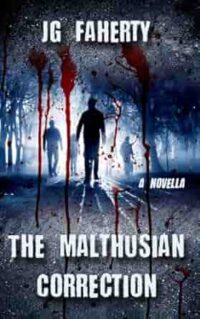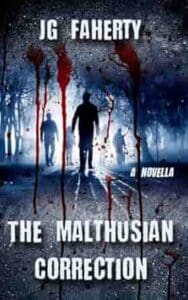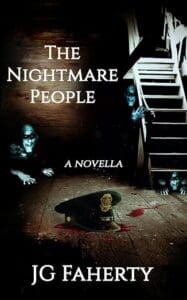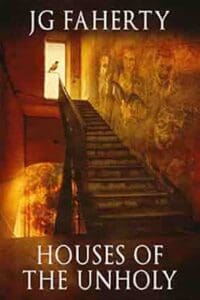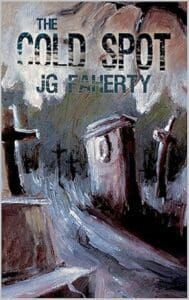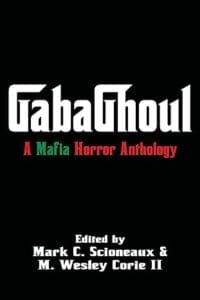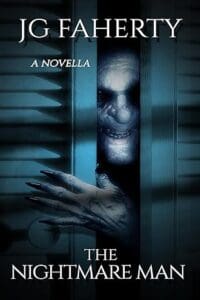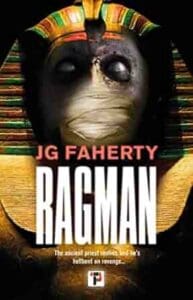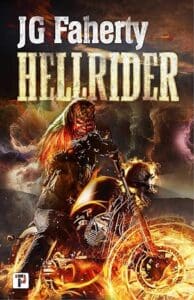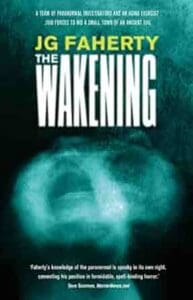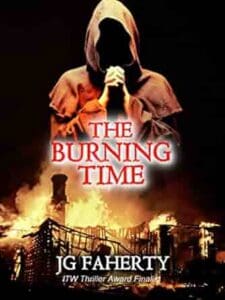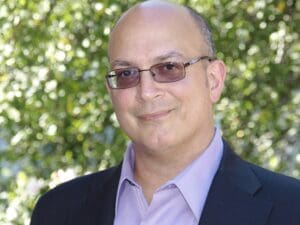Almost two years since our last interview, accomplished author JG Faherty checks in to discuss two horror novellas, The Malthusian Correction and The Nightmare People, both on the edge of release, very different stories but both stunning–enjoy the insights!
The Malthusian Correction (available May 27, 2025!)
When Roger Brenner leaves the house because he has the urge to take a walk, no one, not even him, realizes he is about to change the world as we know it.
Roger’s sudden desire quickly turns into something more as both his mind and body begin to change. He is consumed by his need to keep walking, and soon he is leaving the small town of Rocky Point behind. By the time his family realizes he’s gone, he’s miles away and entering an altered state of consciousness.
As the days go by and Roger continues his unnatural journey, his body begins to deteriorate. He also attracts followers, all of them murmuring the same chilling phrases: “Walking” and “Must keep walking.” The growing horde travels down the East Coast, getting larger every day, with more and more of the walkers devolving into shambling, undead creatures. In less than a week, the phenomenon spreads across the world, causing religious and political upheaval. The governments fear it’s a disease. Religious leaders claim it’s a sign of the apocalypse. And scientists say it’s nature correcting overpopulation.
The same questions plague all of them:
When will it end?
And what happens next?
The world is about to find out.
The Nightmare People (available June 10, 2025!)
Forty years ago, rookie cop Bill Furman pursued suspected serial killer Arthur Blanke into the basement of Blanke’s house and witnessed something that has given him nightmares his entire life.
Blanke turning into a demon and disappearing from a locked room.
Now Furman is Chief of Police, and gruesome murders are once again rocking the small town of Moonrise Cove in North Carolina. Children and their parents torn to pieces. Other children missing. The crimes are eerily similar to the ones Arthur Blanke committed. But they also seem to have something to do with Allison Navarro’s family. Furman is aware Allison and her children survived an attack by a similar serial killer in Rocky Point, New York, twenty-five years ago. His suspicions about her family’s involvement grow stronger when Allison’s estranged son, Ken, is arrested at one of the murder scenes telling tales of a Japanese demon, the oni, being responsible.
Furman’s life is turned upside down when he and Ken come face to face with the demon and he learns that it’s been responsible not just for the deaths in Moonrise Cove and Rocky Point, but for hundreds, perhaps thousands, of deaths around the world. Because the oni is the Boogeyman of legend.
And it’s out to finish the game it started decades ago.
The Interview
The Malthusian Correction
1. The Malthusian. The description of The Malthusian Correction (above) overstates the unity of scientific opinion in your book, but one character does refer to population correction and the theories of the eighteenth-century political economist Reverend Thomas Malthus, named in your title. I’m only familiar with Malthus because of a very weird course I took in college. How did you come across his thinking? What gave you the idea of exploring his ideas in horror fiction? Did Malthusian thinking spark the idea for the novella, or did its inclusion come later? Either way, how did this unusual storyline take shape in your mind? To some, Malthus’s ideas might seem a little crazy… but he was a legitimate forerunner of Darwin, whom history takes much more seriously. Do you think there might be any validity to the idea that nature could “correct” overpopulation through its own devices? Why or why not?
JG: I was a biology major the latter half of my college years and also in grad school. One of the classes I took involved population modeling for an ecosystem, and we briefly touched on Malthus’s theories as they related to biological systems—like what you see in rodent populations when things get too crowded, or when predator-prey numbers get out of whack. Of course, that was 40 years ago, so I had to go back and look up some of the details to make sure I remembered things correctly.
The idea for the story didn’t come from that, though—that came from me reading the news and seeing all sorts of stories about plane crashes, wars, rising murder rates, etc., and wondering “what if all of this, the death tolls, the rising hatred and frustration we see in social media, the so-called ‘accidents,’ was really just the result of us over-populating the world? In nature, when one species gets out of control, some kind of check always balances it out. Either predator numbers increase, or the species consumes all its food sources, and starvation thins the herd. In rodents, especially mice and rats, if there are too many in a closed system (like a cage), they begin to murder and even cannibalize each other. Heck, even primate troops resort to violence when things get crowded, either killing or driving out members of the tribe.
So, once I had my plot, it was simply a matter of figuring out the basics: what tone did I want (scary, weird, action-oriented), what kind of correction would it be, and what was the outcome. And the answer came to me almost immediately. Lemmings. Now, we know that in real life, the whole idea of lemmings committing mass suicide is not really a thing. But it was perfect for my story, and since lemming suicide isn’t real, I needed a different scientific explanation. And that’s where natural correction came in, and from that the side-track of Malthus, and from that both the tone (weird) and the title.
It sounds like a lot, but I needed probably all of ten minutes to think of the plot once the idea appeared and another ten to look up the Malthus information to make sure I remembered it correctly.
As for my premise being true (nature correcting overpopulation), who knows? I do believe that overcrowding leads to violence and anger and stress. I think it’s why you see more violent crime in cities than in suburbs or the country. The more people you have jammed together, the higher the stress levels and the shorter the tempers. And in a way, rising grocery prices are the modern equivalent of natural resource shortages. Look what happens when there are empty shelves in the stores. People instantly turn feral. Most of us are one bad month, socio-economically, from going full lizard-brain.
The real question becomes, is there an overall driving force behind all this—God, Mother Nature, some higher power or almighty entity—or is it just how all things are hardwired at the most basic genetic levels? That any species will inherently do the same things in a similar situation because that’s simply how it has to be for nature to work properly?
I actually have a couple of short stories that explore this from different angles, which I hope will see the light of day (publication) in the near future.
——————
2. The Surreal. When Roger’s wife tries to communicate with him during an early phase of his walk, she experiences the interaction as “like a dream. Or an acid trip.” Readers know Roger feels “purpose” in walking, but the nature of that purpose—the motivation behind his and others’ bizarre, self-destructive behavior—remains obscure, making me feel like Roger’s wife does during that early moment through much of the story. Did you set out to create a surreal reading experience? If so, why, and what aspects other than the walkers’ bizarre behaviors contribute to the surreality? Either way, what do you think “acid trip” moments contribute to the story’s horrific impact? What does the bizarreness of what’s happening do to people in the world of the story, and what do you expect it to do to people reading the story?
JG: I absolutely wanted the entire story to feel surreal, but not in a Twilight Zone way. I was going for weird. Keep the reader guessing to the very end, yet with a few clues scattered around. I didn’t want “scary.” Not in the usual sense. In order to do that, and to make sure neither Roger’s wife nor the authorities could stop him and his followers, I had to create something that was somewhere between zombie and fanatic. One of the examples I use in the story is when Roger’s lawyer reminds people that no one blinks an eye when someone wants to walk across the US for charity or swim the English Channel or do other crazy-sounding stuff. But I also needed Roger not to be “normal” anymore. Is it a disease? Has he been taken over by a higher power? Obviously, something supernatural is at play, as we see throughout the story’s progression. But it’s slow, and by the time people realize it, the whole phenomenon is in full force.
In a way, this is an offshoot of a non-zombie, non-apocalyptic zombie apocalypse novella I wrote (along with a follow-up short story) a few years ago. It’s called December Soul (the short story is “The Lazarus Effect”). Both are in my collection Houses of the Unholy, and they describe how a growing segment of the population suddenly stops eating, stops speaking, and just starts gathering in large groups. Wherever those groups appear, more people become like them and join them. No one knows why. No one can explain how they don’t starve to death or die. But as more and more of them happen, suddenly society is in trouble because it’s breaking down. All these peaceful people just standing around or walking in big groups through the streets and parks and neighborhoods. I won’t give away the ending, but it turns out to be something other than what it seems to be.
That was another part of The Malthusian Correction that I enjoyed exploring. The idea of zombies that didn’t eat brains, weren’t violent, weren’t really zombies except that they were dead and still walking.
My hope for this story is two-fold. One, that readers are entertained. And two, after they experience the thrills and chills of the story, the chills part sticks with them and comes back each time they read the news about another plane crash or mass murder.
——————
3. Voyeuristic Frenzy. You provide a fair bit of information about the media response to the walker phenomenon, and some media representatives seem to try to prolong the phenomenon because it gets good ratings. Are you critiquing how media outlets tend to respond to unusual and potentially tragic events? Showing what you think would be a realistic response to such events? Both? What about people who come to watch the walkers as their numbers grow—does your book judge their voyeuristic curiosity? Why or why not? What’s significant about the desires to see and to know that you portray? How do they relate to your readers’ desire to “see” and know more as they read along?
JG: I think it’s a pretty realistic representation of how we’ve seen both media and onlookers react to tragic and tumultuous events. Would the media exploit something like this? Absolutely! Look at coverage for everything from storms (often blown out of proportion for days in advance), wars, politics, everything. It’s 100% about ratings now, and scooping the competition, and keeping people glued to their TVs, phones, etc. There is no journalistic integrity anymore, and even if a reporter had some, the station would either poison it or fire them.
As for the people—there would definitely be hordes of onlookers. People come from miles away to see anything unusual. Dead whale on the beach? Let’s go! Brush fires in the hills? Let’s drive past and see them. Sinkhole opens up? Plane crashes in the woods? Gotta check it out! It’s simple curiosity, and in some folks it overrides common sense. You’ve seen them. The ones that have to get right to the very edge of the Grand Canyon, where one wrong step sends them over the edge, just for the perfect selfie. The ones who stand and watch while a crime is being committed, like a bank robbery or a hostage situation, all of them right up to the edge of the police barriers. Do I think people would come watch dead people marching through town, even at the risk of becoming one? Yes, I do.
Does that relate to readers wanting to keep going with the book? No, I don’t think so. One is voyeuristic curiosity; the other is being caught up in an interesting story. Although I guess an argument could be made that the onlookers are there because in a way they’re being entertained.
——————
4. Religious Frenzy. When Roger’s wife tries to stop his walking legally on mental health grounds—he may be a danger to himself or others—people object for various reasons, particularly because he has a right to go on a religious pilgrimage even if doing so is detrimental to his health. Why are people so quick to ascribe religious significance to his seemingly inexplicable behavior? As more people join the walk, religion and public health concerns come more and more into open conflict. To what extent did similar conflicts over vaccination, particularly during the COVID crisis, influence your representation of this conflict? Does your book take a position? Why or why not? Caring for the mental health of walkers seems to be especially at odds with religious aims. How does this conflict resonate with what you see in the world outside your fiction?
JG: One of the things I’ve found about my writing is that rarely are the underlying themes or subthemes—in this case, religion vs. science, religion vs. politics, politics vs. science, etc.—part of what I have in mind when I start writing. Often, I don’t even catch them until after I’m going back to edit, or, in some cases, when reviewers mention them. That was a huge shock for me when I wrote my very first novella (The Cold Spot) back in 2012 (wow, so long ago!). In that book, I came up with the title because the main character, a kid who’d been bullied because of a birthmark on his face, discovers a cold spot in a cemetery that is from the presence of ghosts. It was only later, when a reviewer pointed things out, that I realized the title had multiple meanings. The boy’s birthmark (he’s cruelly nicknamed Spot) has turned him emotionally cold. And he’s placed in situations where the people (and ghosts) closest to him end up doing terrible things (he is in cold, hard environments).
A similar thing happened with The Malthusian Correction. I definitely wanted there to be some involvement with religious groups. How could there not be? Once it’s shown that Roger and his followers are dead but not-dead, and especially after the one scene where they should all be dead but they “return,” it’s like events from different religious tales are occurring in real life. Is it a second coming? Is Roger Jesus? Is it the apocalypse? Or, as some of the atheists and scientists proclaim, does it mean that there is no heaven, no hell, that non-death, or after-death, is simply another state of being? Do the dead have souls, or are they simply automatons?
Religious groups would be arguing like crazy. And, again reverting back to basic human nature, new religions would spring up. Humans are nothing if not predictable.
On the other hand, when it came to the health aspects of the situation (dead people marching through towns, possibly carrying deadly diseases), I had no thoughts about COVID as a key plot point. I simply went with what I thought would be a standard healthcare and military reaction to a situation like that. I’ve worked in the biological sciences, including some time working with infectious diseases, and I have friends who are virologists and bio-geneticists. Who’ve worked at the CDC or NIH. I didn’t want this book to be a statement about COVID; however, there were obviously some basic parallels because even if COVID never happened, a situation like this would still require an epidemic/pandemic-type of response at some point. Those procedures were always in place; COVID simply made more people aware of them.
——————
5. The Walking Dead. The description of your book mentions the walkers becoming “undead.” I’ll venture that it’s atypical, but how is and isn’t The Malthusian Correction a zombie story? You give Jonathan Maberry and Brian Keene cameo appearances and mention other horror along the way—what works were your major influences? Did you set out to write a fresh take on the zombie? If so, why do we need a new zombie for 2025? If not, even though the Z word is one of many conceptual frameworks people use to try to explain your walkers, how are your walkers not zombies? Why would and/or wouldn’t you want to put The Malthusian Correction in the zombie subgenre?
JG: I’ve written a lot of zombie stories, despite the fact that I don’t typically enjoy zombie stories (or movies, or TV shows). The reason I don’t usually enjoy them is they are so predictable. Slow moving zombies take over the town, or the world, or whatever. Fast moving zombies take over the town or the world, or whatever. People have to band together to stop them. Keene’s zombies were a bit different because some of them could think. Maberry’s zombie books are good in large part because he focuses more on the people than the zombies, making the terrors more realistic. But stuff like The Walking Dead, man, that gets old real fast. That series should’ve stopped after Season 3. Same with The Last of Us – it’s already reaching the point where it’s right back to the overused “warring communities” plot. (I can’t comment on either of the comic series because I don’t read comics much and haven’t since the mid-90s.)
What happens with me is that when I come up with a zombie-type story, I immediately throw it out unless it happens to take the genre in a very different direction. For instance, in “Home on the Range,” zombies are trainable and can be used as day labor and illegally as sex workers. In “Family First,” a man succumbs to a zombie bite and then wakes up to find that as long as he eats brains, he can remain a normal, fully functioning rational person, and now he has to rescue his family before the zombies get them—except the effects of brain eating only last a few hours. In “Marshal Law,” the reanimated corpses have an agenda, which you can guess from the title. In “Street Action,” zombies are part of society but there is a serious prejudice against them, and one decides to rebel. Most recently, “Mezzamort” is featured in the GabaGhoul anthology, with warring zombie mobsters as the heart of the plot.
I love taking the idea of the zombie and turning it around, twisting it into new shapes, making it something it’s not. So, as I wrote The Malthusian Correction, I consciously made sure it wouldn’t be a Walking Dead knock-off. Are Roger and his followers zombies? I guess that depends on your definition. At some point, they are dead. And they still move. If the definition of a zombie is that, then yes. But then vampires, mummies, ghouls, Frankenstein’s monster, and lots of other scary creatures would be zombies. Roger et. al. don’t eat flesh. Don’t kill anyone. Haven’t emerged from graves.
Would I put it in the zombie subgenre? Maybe, in the broadest sense.
Do we need a new zombie for 2025? Probably, and probably not. Unlike me, a lot—a real lot!—of people enjoy the tried-and-true zombies. So I think you could maybe have a new kind of zombie, but it would be in addition to the classic ones, rather than replacing them.
——————
The Nightmare People
6. Nightmare Influences. References to serial killers run through The Nightmare People. On the one hand, serial killers are a rationalization of the demonic, but on the other—are serial killers the kernel of your monster’s horror? A real serial killer, John Wayne Gacy., who killed children, gets mentioned at least once, and a fictional serial killer who kills children, Freddy Krueger, gets mentioned at least twice. In his movies, Freddy gets called “the boogeyman” and is certainly a nightmare person—how do real-life child-killing nightmare people, movie-spawned child-killing nightmare people, and your child-killing boogeyman relate? Your novella also mentions Stranger Things, a TV show in which entities from another realm repeatedly threaten kids. Your story alludes to another realm, and “Nightmare People” might refer to characters having nightmares as well as “people” monstrous enough to inspire nightmares—would you place your novella in a cluster with serial killer stories, Nightmare on Elm Street, and Stranger Things (perhaps with the horror turned up to eleven)? Why or why not?
JG: Wow, that’s a lot to unpack! Like I mentioned above, I don’t usually think about that deep stuff when I’m writing, at least not consciously. I think, for my thought process, it was more basic. If the boogeyman really did exist, it (or they) would be considered the most outrageous and prolific serial killer(s) / psychopath(s) in history. Frightening children. Stealing them. Killing them. Depending on which legend you examine, the boogeyman (or equivalent) is pretty awful.
With that in mind, I had to look at it from a cop’s point of view (because in book 1 of the trilogy, The Nightmare Man, a cop was one of the main characters, and that continues into books 2 and 3). No cop is going to believe in a supernatural serial killer. Heck, my two cops don’t, and they’ve both encountered the boogeyman! In these books, the cops do what most people would: try to rationalize what’s happening. The pop culture references, like Freddy Kreuger or John Wayne Gacy, I threw in because I think people would talk about them in conversation. The cops I know certainly would. And the manner of the deaths—the bodies being sliced up, chopped up—is reminiscent enough of horror movies to make those comparisons logical.
Imagine you’re in a dimly lit room and you see this tall, monstrous thing with long claws butcher someone. All adults know monsters don’t exist. So there’d very quickly be rationalizations. Man in a gorilla suit. Man with home-made Freddy Kreuger knife-gloves. Eventually, our heroes come to accept that there is no rational explanation except that the kids in the story are right: it’s the boogeyman. But without having seen it themselves, many of the adults, including FBI agents, learn the lesson too late.
I suppose that someone somewhere has done psychological studies about serial killers of children, people who think they’re the boogeyman, who were scarred as little kids by those stories or by being victims of serial killers or whatever. My books aren’t the place for that. I think if you start going that deep with what is essentially a horror thriller, you steal some of the inherent fear from it and it becomes more of a study object than entertainment.
I just wanted my cops to act like cops, my kids to act like kids. To be scared. To be wrong.
As for where I’d place this in the genre, I think I’d shy away from calling it a serial killer book. Sure, the boogeyman is a serial killer in the strictest definition, but then so would be Dracula. The Mummy. Any monster with a list of targets to kill. That would make my mummy novel Ragman a serial killer book, too! It’s a police procedural just like the Nightmare World trilogy. Maybe that’s the best description: Supernatural Police Procedural.
——————
7. Nightmare Images, International Boogeymen. This novella is gory, and a lot of the flying body parts belong to kids. Do you feel that it’s risky? Why did you decide to be so explicit? Even though the U.S. has come a long way in terms of what it will allow onscreen, I imagine a film adaptation would tone it down a bit… but as the description (above) indicates, your monster is global, so a film adaptation wouldn’t have to come from the U.S. The “oni” is Japanese: does your rather extreme monster have any relation to Japan’s historically more extreme horror cinema (the works of Hisayasa Sato and Takashi Miike, for example)? Even if it doesn’t, for your mostly American characters, does the oni’s foreign dimension increase the terror it inspires (the only thing Japanese most of them seem to know is Godzilla, mentioned twice)? Ultimately, how does your monster’s global reach affect its grisliness?
JG: Well, I don’t imagine there’ll ever be a movie made from this trilogy! Like you said, chopping up dozens of kids isn’t what most moviegoers are looking for. What made me be so explicit was I never had any intention of pitching this trilogy to a Big 5 publishing house. I knew as soon as I started writing that it would be a little gorier than what I normally do (but let’s be honest—it’s not “extreme horror” gory; it’s not Human Centipede gross or even Texas Chainsaw Massacre bloody; however, it’s kids, so….) and that it would either be something for the small press or to self-publish. Luckily, Lycan Valley Press liked it and agreed to do all three books.
It’s funny that you mention Japanese horror. It was the oni legend, through the game of hitori kakurenbo, that crystallized the plot for me. I had this real vague idea about a boogeyman who follows a boy from childhood to adulthood, but I didn’t want to do the US version of the boogeyman because it’s so familiar. So I started googling boogeyman legends, and I came across the Japanese one and also the Puerto Rican one (the cuco). That’s when I had the idea that two different people could be haunted by the same monster, and if they somehow came together… So, in order to do that, I had to have Ken play the hitori kakurenbo game as a little boy, call forth the oni, and set everything in motion.
And here’s a little secret: Aside from the Godzilla universe movies and a couple of other films (Ringu, Dark Water) I’ve not seen much Japanese horror, and I can’t stand anime or manga; in fact, the inclusion of that type of drawing is what made me stop reading Marvel comics in the 90s. So that style of horror had zero influence on these books. I simply chose a Japanese setting to start the trilogy because it made the best sense as a plot initiator.
——————
8. Monster! When they see your monster, several characters shout, “Monster!” Encountering it seems to make knowing it is a monster almost instantaneous and inevitable. This thing isn’t Frankenstein’s sympathetic Creature. There’s no doubting this thing is bad news. What allows characters to recognize the creature’s undeniable badness? You emphasize sensory details. Why the glowing red eye? What aspects of size and shape make the monstrous? Why the animal features—hair, teeth, claws? What about sounds? Why so much emphasis on smell, and why the specific smells? To sum up with a big word, what’s the key to your epistemology of monstrosity?
JG: The thing about horror is, when you start writing about monsters, how can you create something new yet familiar? How do you describe something that everyone knows, and yet still make it scary? Conversely, how do you describe something no one’s ever seen before and make it scary without going overboard on details?
This was my conundrum for the boogeyman creatures in The Nightmare Man, The Nightmare People, and, preparing for line edits as we speak, the final book in the trilogy, The Nightmare World. In the US, the boogeyman is described in all sorts of different ways. But one of the nice things about the Japanese oni and the Hispanic cuco is that they actually look similar. Big, ogre-like or Bigfoot-like creatures, hairy and toothy and really mean. To that I added my own details: red eyes (yes, it’s been done a lot, but I wanted them very visible in the dark) and an awful smell. I mean, think about it. All those fables and bedtime stories about boogeymen, but none of them go beyond how they look and maybe that they whisper or growl.
They’re monsters. Monsters that live on human flesh and carve people into pieces. Meaning they have to get covered in gore. And you know they aren’t showering when they get home. They should stink really bad. I tweaked that a little to add the fart smell. Why not make them stink as bad as they look? Plus, smell is a great way to foreshadow the appearance of one, or realize one has been there in the aftermath of a murder.
There’s also this: any good writer or editor will tell you that a story should encompass as many senses as possible, not just vision. It helps immerse the reader in the story.
The reason for the claws: gotta slice them bodies up somehow.
The reason for the teeth: gotta eat that flesh, plus they’re scary looking.
Nice thing about a monster is that I can create a whole race of boogeyman creatures, and they can be different from everyone else’s, but it’s still right, because there is no wrong.
The one thing I try to do, though, with all my monsters, is make them believable. Sometimes a monster can be so “out there” that it becomes laughable. I don’t want that. I create my monsters—whether they be boogeymen, Lovecraftian beings, mummies, ghosts, were-creatures, zombies, Krampus, etc.—with a healthy mix of legend and scientific possibility. Not probability, but they pretty much adhere to the natural laws of physics and somewhat with the laws of nature and biology. Although I have no problem stretching those!
The last thing I want is someone reading one of my books and thinking, “that monster is stupid.”
I want them to say, “oh, hell, this almost seems like it could happen.”
——————
9. Big World-Building, Short Book. You do so gracefully, but you squeeze a lot of world-building into this short book, developing not only a significant cast of regular people but also a monster associated with deep lore and a realm you merely sketch. What’s the personality of Moonrise Cove? Without giving too much away, what sorts of things can readers expect to learn about the demonic oni and its realm? With all the world-building you’ve done, do you expect to revisit some of this material—might there be more from the realms of The Nightmare People?
JG: From the minute I came up with the idea for The Nightmare Man, I knew it would be a trilogy of novellas. The way it was structured in my head and in my first outline wouldn’t work with a single novel, even if that novel went 120,000 words. Too many ups and downs in terms of climaxes.
And I saw everything clear as day. Book 1 (The Nightmare Man) would set everything in motion. Two of the three key characters (Ken, Rob) and their family, and the history of the oni/cuco in their lives. Book 2 (The Nightmare People) springs us both forward and backward in time, as we meet Chief Furman and find out his involvement with the boogeyman and set up the intersection with him and Ken’s family. Book 3 (The Nightmare World) will take us back to that place where Rob and his daughter visited, the alternate reality where the boogeymen come from.
At the same time, the titles show how the cast and stakes grow larger: Nightmare Man represents both the oni/cuco and Ken or Rob. Nightmare People gives us several more characters dealing with the demons. And Nightmare World will not only take us across the divide, but it also represents how bad the situation in Moonrise Cove has become.
Nightmare Man takes place in the fictional town of Rocky Point in upstate NY. When I wrote it, that’s where I lived (it’s based on a combination of two towns, Stony Point and Haverstraw) and where a lot of my books and stories have been set. When I moved to North Carolina in 2024, I created the fictional town of Moonrise Cove, which is situated between and above Wilmington and Leland. The next question is going to be why do that, and my answer is, I like writing about the areas where I live. Especially small towns. You can work in so many tiny details that make a story more authentic.
And I won’t lie, it comes in handy when the local library or bookstore is looking for a “local author” for an event or if you want to sell your books locally and you can say “takes place right here in town!”
Of course, I’ve also written about places I’ve visited a lot (Ragman is set in NYC, Hellrider is set in the Everglades of Florida) or previously lived (upstate NY, the town of Olean, where I was born and went to college, is the basis for my town of Hastings Mills and the setting for books such as The Wakening and The Burning Time), and also places I’ve never been. But sooner or later, I end up writing about “home” again.
——————
10. Access! How can readers learn more about you and your works (please provide any links you want to share)?
JG: Well, the easiest way to keep up with me and what’s going on is to visit either my website (www.jgfaherty.com) or my Facebook page (www.facebook.com/jgfaherty). I’m also semi-active on X (@jgfaherty) and Instagram (@jgfaherty). My books can be found on Amazon (JG Faherty) and Barnes & Noble.com (also JG Faherty). In addition to The Malthusian Correction and The Nightmare People, I also had another novella come out in April (When September Ends, a story about a girl haunted by the evil ghost of her dead sister). Later this year I’ll have some short stories coming out in various magazines and anthologies, and probably late this year or early next will see the release of The Nightmare World, concluding that trilogy.
Right now, I’m currently pitching a supernatural eco-thriller that really stretched my writing, I think, as it’s a type of story I haven’t done before, and I’m currently half-way through writing another novel that is very much traditional supernatural horror, but without any of the gore found in the Nightmare World trilogy. In June I’ll be at StokerCon in Connecticut, and in October I’ll be at the Myrtle Beach ComicCon. I’m still working on other events in between.
Other than that, you can find me on the golf course, at the beach, at a local food truck rodeo, or just sitting in the backyard sipping a bourbon.
Andrew, I just want to say thank you for having me as a guest; your questions are always thought provoking and interesting!
About the Author
Born and raised in New York’s haunted Hudson Valley and more recently a resident of North Carolina’s equally haunted Cape Fear region, JG Faherty is the author of 23 books, 4 collections, and more than 90 short stories, and he’s been a finalist for both the Bram Stoker Award (twice) and ITW Thriller Award. He writes adult and YA horror, science fiction, dark fantasy, and paranormal romance, and his works range from quiet, dark suspense to over-the-top comic gruesomeness. He is proud to be a relative of Mary Shelley. You can follow him on X, Facebook, and Instagram as @jgfaherty.

